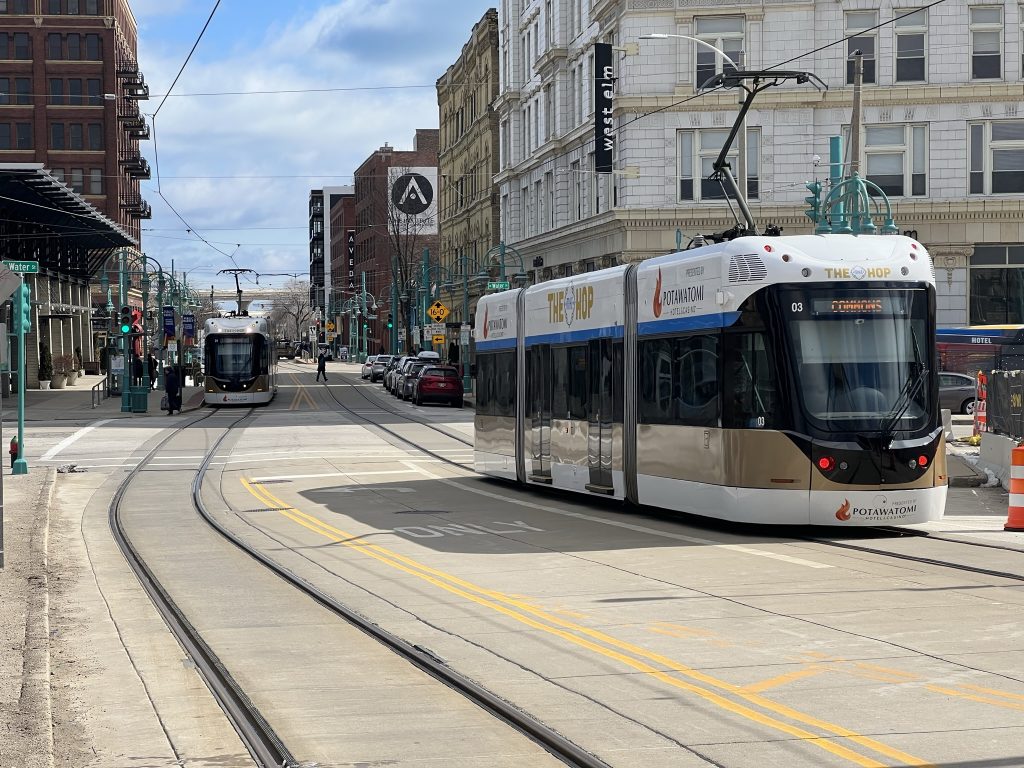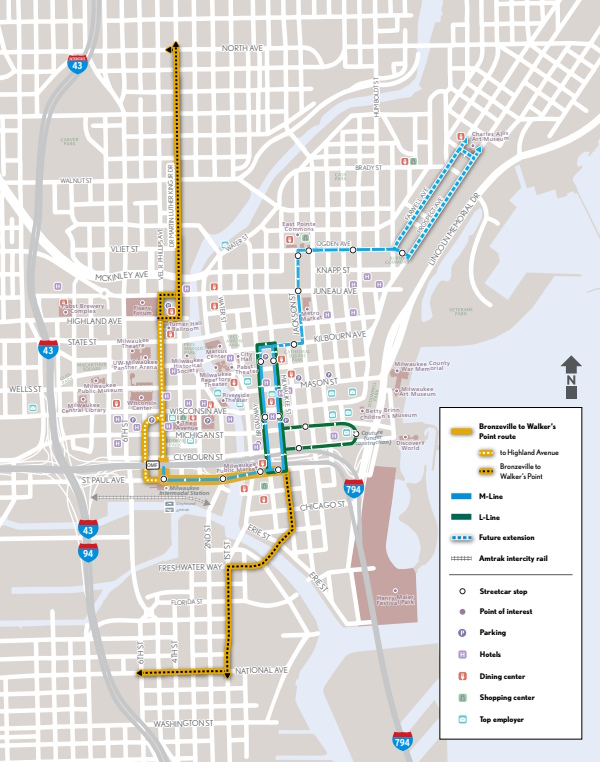Committee Backs 4 Streetcar Extensions
If federal grants received, system could reach Fiserv Forum, East Side, Bronzeville and Walker's Point.
The City of Milwaukee is preparing to move forward on four different streetcar extensions as part of the Common Council’s larger moves to respond to new state policy restrictions.
But it won’t result in any shovels in the ground anytime soon.
The Department of Public Works would be directed to pursue federal grants to fund the majority of four extensions: a Lower East Side line to Brady Street via N. Prospect Avenue and N. Farwell Avenue, a Westown line to Fiserv Forum via N. Vel R. Phillips Avenue, a new line north from Fiserv Forum to Bronzeville and a new line south from the Historic Third Ward to National Avenue in Walker’s Point.
The city would need to find local funding to partially match any federal grant. But it will need to do so with the new state-imposed restriction that it can’t spend any property tax revenue, nor its proposed sales tax, on the project.
“This is basically a resolution that directs the Commissioner to pursue what we had intended to accomplish in 2011 and 2015,” said Alderman Robert Bauman on Monday in introducing the proposal to the Steering & Rules Committee.
The Lower East Side and Westown extensions are “shovel ready,” said the streetcar advocate. They were studied and designed as part of the original streetcar project going back more than a decade, but remained unbuilt because the city’s federal grant didn’t offer enough funding.
Bauman touted the economic growth along the current corridor, including that properties within a quarter mile of the existing 2.1-mile route now represent 13.9% of the city’s property tax base. He said further encouraging growth in Downtown would increase revenue to fund services citywide.
“The bottom line that somehow the streetcar is a burden on the city is the exact opposite of reality,” said Bauman. “This is an economic engine, not an economic drain on the city.”
In 2019, with a push to get a portion of the Westown extension built in time for the Democratic National Convention, then-Mayor Tom Barrett‘s administration tried to get things moving on the larger extensions, only for the council to hold off. The COVID-19 pandemic and the city’s then-deteriorating fiscal condition then halted any further discussion.
Now the discussion is back, but not because the city has money. Instead, it’s returned primarily because Republicans in the Wisconsin State Legislature included the funding prohibition in the policy that authorized a new city sales tax.
The council also is in the process of setting aside money for potential legal challenges to other provisions in the bill, including restrictions on equity programs, minimum police staffing requirements and requirements for super-majority votes on new spending. It’s also moving to reorganize the city’s lobbying division.
The council’s looming vote isn’t to build new streetcar extensions but to seek federal money to build them.
City Engineer Kevin Muhs, who has immense transit funding knowledge from his time as the head of the Southeastern Wisconsin Regional Planning Commission, said the city could expect to see the federal Small Starts program pay for 70% of the project costs.
He said the city would fare well in grant scoring for job density and jobs served by the extensions, but would need to mitigate other factors. An estimated cost for the extensions would also need to be developed.
But how would the city pay for the other 30% and the cost to operate the line? Bauman said the city was considering its options.
He pointed to the 31-story tower under construction in the Historic Third Ward, whose future property tax payment would be equivalent to 25% of the system’s operating budget, as an example of how the system is already working.
A new extension to The Couture, funded as part of the original $128 million plan in 2015, is slated to finally open later this year after the tower’s delays ended up delaying the project.
“That economic development tool has worked,” said Bauman.
His colleagues appeared to agree, with the committee voting 6-2 to advance the project with little discussion.
There is a benefit to including the streetcar expansion alongside all of the other policy responses: less desire for opponents to delay the process. The committee meeting Monday lasted more than five hours, with relatively little time spent on the streetcar proposal.
Ald. Mark Borkowski, a longtime opponent, was the lone individual to speak against the proposal. “I opt not to grandstand and I will stay consistent with my opposition,” said the alderman. Ald. Scott Spiker also voted in opposition.
The full council is scheduled to vote on the grant application request on July 11.
For more details on the proposed sales tax and other impacts of the state’s Act 12 law, see our earlier coverage.
Legislation Link - Urban Milwaukee members see direct links to legislation mentioned in this article. Join today
If you think stories like this are important, become a member of Urban Milwaukee and help support real, independent journalism. Plus you get some cool added benefits.
Related Legislation: File 230354
More about the Milwaukee Streetcar
For more project details, including the project timeline, financing, route and possible extensions, see our extensive past coverage.
- Another Streetcar Collision - Jeramey Jannene - Jun 27th, 2025
- Streetcar Hit By Apparent Red Light Runner - Jeramey Jannene - Jun 16th, 2025
- Streetcar Will Run On Consolidated Route During Summerfest - Jeramey Jannene - Jun 11th, 2025
- City Hall: Milwaukee Must Replace Failing Streetcar Switches - Jeramey Jannene - Feb 24th, 2025
- Streetcar Confronts Limited Funding, Operations Challenges - Evan Casey - Jan 22nd, 2025
- Council Kills Streetcar’s ‘Festivals Line’ - Jeramey Jannene - Jul 31st, 2024
- Streetcar Will Use Festivals-Oriented Route Through Summer - Jeramey Jannene - Jul 9th, 2024
- The Hop’s Lines Will Merge For Easier Summerfest Service - Jeramey Jannene - May 30th, 2024
- Streetcar Begins Daily Service To The Couture, BRT Will Soon Follow - Jeramey Jannene - Apr 11th, 2024
- Milwaukee’s Three Streetcar Extensions Need Mayoral Direction - Jeramey Jannene - Nov 8th, 2023
Read more about Milwaukee Streetcar here
Political Contributions Tracker
Displaying political contributions between people mentioned in this story. Learn more.
Transportation
-
MCTS Adds 28 New Buses
 Jul 13th, 2024 by Graham Kilmer
Jul 13th, 2024 by Graham Kilmer
-
MCTS Designing New Bus Shelters
 Jul 10th, 2024 by Graham Kilmer
Jul 10th, 2024 by Graham Kilmer
-
MCTS Updates RNC Bus Detours To Better Serve Downtown, Riders
 Jul 9th, 2024 by Jeramey Jannene
Jul 9th, 2024 by Jeramey Jannene























This streetcar expansion is essential to our quality of life, future business, entertainment, and residential development, and as a go-to destination for tourism and conventions. There is no reason additional advertising sponsorships can’t come from the very entities that will benefit from expansion most, like the Bucks, Fiserv, Kohls, Target?, Northwestern Mutual, Baird & the convention district, the lodging & restaurant industry, Summerfest (MWF), 3rd St Market Hall, MAM…
If we have to resort to a miniscule buck per ride to help fund the expansion (with entities mentioned above providing free ride tokens to guests, patrons & employees) so be it. It will still be a huge bargain and car alternative, but only if we can expand beyond its current narrow boundaries.
The Hop streetcar is the butt of a lot of jokes but its expansion is very important. The more places it reaches, the more ridership will increase. I’m glad to hear there is support for its expansion. But I wish the streetcar itself would get quicker with more priority on the street. Its annoying to have to stop at lights and wait for cars in the way.
Especially if the Hop is built out as shown, there will be a one-block “missing link”—a key gap whose addition should be considered. There should be a westbound track added to Clybourn from Milwaukee to Broadway to allow cars to travel directly from the Couture to St Paul and the garage without detouring up to Kilbourn.
Adding this one block of track would allow the entire built-out Hop to operate with just two direct routes:
(1) Bronzeville—Couture
(2) Lower East Side—Walker’s Point
Without this one added block of track, the built-out system would require at least 3 different routes (shown as yellow, blue, and green in the map) instead of two. Fewer routes means less cost which allows more frequent service on those two routes.
Also, if the system is built out as shown, the Hop might consider adding a single track across the river on Kilbourn from Broadway to MLK. A single track like this could be used for 2-way traffic in an emergency (if the St Paul bridge is unavailable—if, say, the bridge gets stuck in a raised position). Without a “spare” track crossing the river, the Hop would be unable to function if the St Paul bridge is out.
This added “Kilbourn Connector” might only be used for emergencies, or it might be used for a new “loop” route (like Kilbourn, MLK, St Paul, Milwaukee)—a really functional downtown “circulator” route.
For the 80% of the citizens of Milwaukee who do not live downtown, nobody cares. This is only “vital” to those who seek to profit off their downtown property. For the rest of the people of this city, why their streets look like minefields, their neighborhoods are plagued with crime, while they pay ever-rising property taxes and receive nothing in return is what they care about. I have a better idea. Stop taxing anyone who is not downtown and let the people who live there pay for this farce. They seem to want it. Nobody else does.
This proposal is very exciting! The current system already works well for those of us who live downtown and tourists, but this will make the streetcar more useful for many more people.